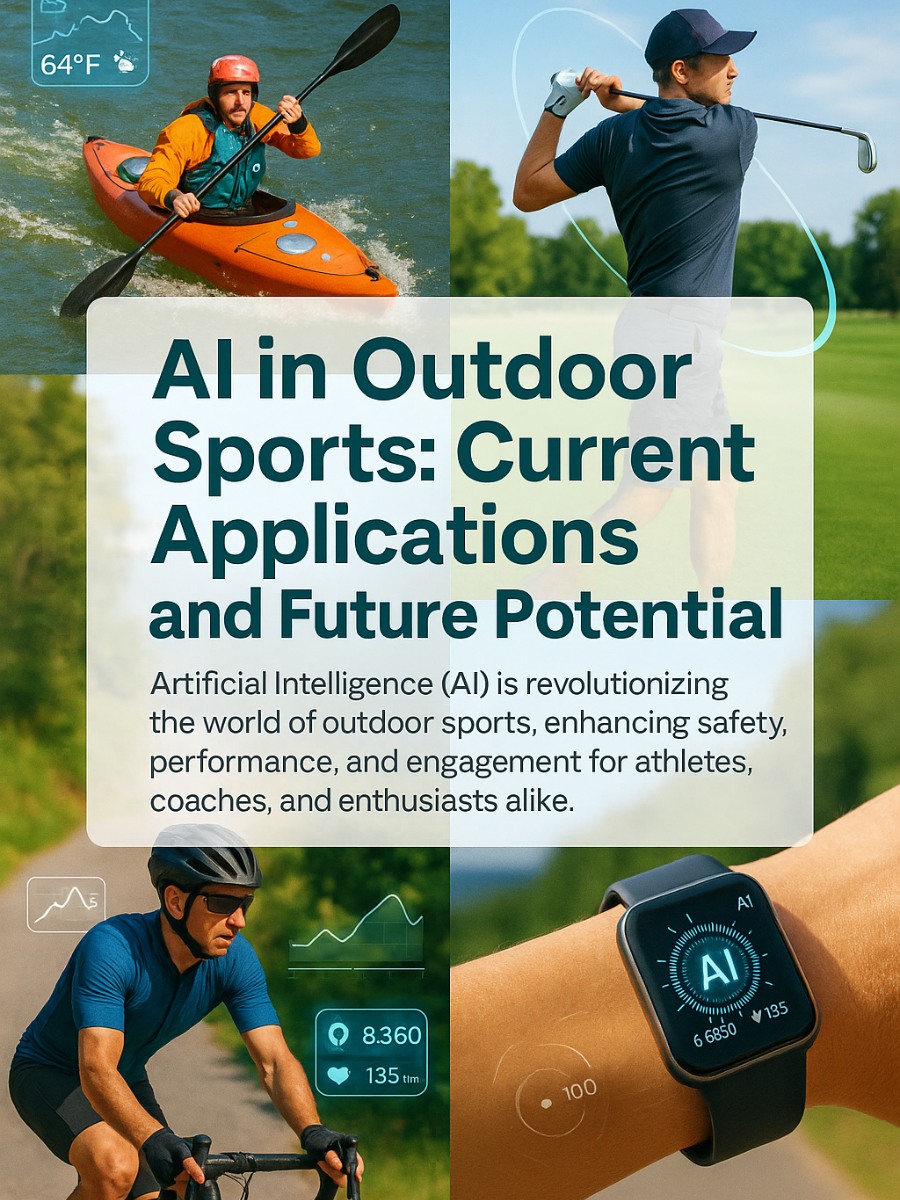
Artificial Intelligence (AI) is revolutionizing the world of outdoor sports, enhancing safety, performance, and engagement for athletes, coaches, and enthusiasts alike.
From kayaking to golf, hiking to cycling, AI-powered technologies are reshaping how we train, compete, and connect with nature.
As we look toward 2025 and beyond, the integration of AI in outdoor sports is poised to unlock unprecedented opportunities.
This blog post explores the latest advancements and the exciting future of AI in outdoor sports.
📘 Table of Contents
Current Applications of AI in Outdoor Sports
Enhanced Safety and Real-Time Environmental Analysis
AI is making outdoor sports safer by analyzing real-time environmental data. For example, in kayaking, AI-powered systems process weather conditions, water levels, and currents to provide paddlers with up-to-date information for safer trip planning. Smart kayaks equipped with AI can alert users to sudden weather changes, such as incoming storms, or potential water hazards, ensuring a safer experience.
In other sports like hiking and mountaineering, AI-driven apps use geographical and environmental data to recommend safe routes, factoring in terrain difficulty, weather forecasts, and user skill levels. These tools help reduce risks by providing real-time alerts about changing conditions.
Personalized Training and Performance Optimization
AI is transforming training regimens for outdoor athletes by offering personalized insights. Wearable devices and fitness trackers, equipped with AI algorithms, monitor metrics like heart rate, muscle tension, and movement patterns. For instance, in running, AI-powered shoes adapt cushioning based on fatigue levels, optimizing comfort and reducing injury risk.
In cycling, AI-integrated bikes use GPS and traffic data to suggest efficient routes tailored to the rider’s goals, whether it’s speed, endurance, or scenic exploration. Similarly, in golf, AI tools like swing diagnostics and predictive performance analytics provide real-time feedback, helping players refine their techniques and strategize smarter.
Community Building and Social Engagement
AI is fostering stronger communities among outdoor sports enthusiasts. Platforms powered by AI recommend local groups, events, or meetups based on user preferences, connecting like-minded individuals. For example, the Flatwater Kayak Club highlights how AI can help lonely or inexperienced kayakers find community, encouraging participation and shared experiences.
AI-driven chatbots, such as Arsenal’s “Robot Pires” in other sports contexts, could be adapted for outdoor sports to provide enthusiasts with real-time information about trails, events, or gear recommendations, enhancing engagement.
Environmental Monitoring and Conservation
AI is playing a pivotal role in environmental stewardship within outdoor sports. By analyzing data from AI-powered devices, kayakers and other outdoor enthusiasts can monitor water quality, wildlife populations, and ecosystem changes. This data contributes to conservation efforts, helping protect the natural environments where these sports take place.
For example, AI can track the impact of human activities on aquatic ecosystems, providing valuable insights for researchers and organizations. This aligns with the #TechForGood movement, where technology supports sustainable practices in the outdoor industry.
AI-Powered Equipment and Gear Innovation
AI is revolutionizing sports equipment design, making gear smarter and safer. In outdoor sports, this includes AI-infused running shoes that adjust to terrain, bikes with integrated navigation systems, and even golf caddies that autonomously follow players using AI-powered cameras. A recent post on X highlighted a smart caddie that recognizes and follows golfers, eliminating the need to carry clubs.
These innovations enhance performance while reducing physical strain, allowing athletes to focus on their experience in the outdoors.
The Future of AI in Outdoor Sports
Advanced Predictive Analytics
AI’s predictive modeling capabilities will become even more sophisticated, enabling outdoor athletes to anticipate challenges and optimize performance. For instance, advanced algorithms could predict fatigue or injury risks based on biometric data, allowing hikers or climbers to adjust their plans proactively. These models will integrate historical data, real-time conditions, and individual profiles for unparalleled accuracy.
In competitive outdoor sports like trail running or mountain biking, AI could simulate race scenarios, helping athletes strategize based on terrain, weather, and competitor data.
Immersive Virtual and Augmented Reality (VR/AR)
The integration of AI with virtual reality (VR) and augmented reality (AR) will create immersive training and fan experiences. By 2031, the VR sports market is expected to reach $56.7 billion, with outdoor sports benefiting from virtual training environments. For example, hikers could use VR to practice navigating challenging trails, while cyclists could train on virtual courses that mimic real-world conditions.
AR glasses could overlay real-time data, such as trail markers or heart rate metrics, onto an athlete’s field of vision, enhancing both training and competition.
Enhanced Fan and Community Engagement
AI will continue to personalize fan experiences, even in outdoor sports. Imagine AI-powered apps that provide real-time trail updates, personalized route recommendations, or interactive challenges for hikers and runners. These tools could gamify outdoor activities, encouraging broader participation and deeper engagement.
For spectators of competitive outdoor sports, such as ultra-marathons or adventure races, AI could generate real-time analytics and visualizations, making broadcasts more engaging and informative.
Sustainable Design and Manufacturing
AI will drive innovation in sustainable gear design, aligning with the outdoor industry’s focus on environmental responsibility. By optimizing materials and production processes, AI can create lighter, more durable equipment with a lower carbon footprint. For example, AI could design kayaks with improved aerodynamics or hiking gear made from eco-friendly materials.
Creative and Strategic Advancements
As AI makes tactical and strategic elements more predictable, creativity will become a key differentiator in outdoor sports. Athletes who can adapt creatively to AI-driven insights will gain a competitive edge. For instance, trail runners could use AI analytics to devise unique race strategies, blending data-driven decisions with human intuition.
Challenges and Considerations
While AI offers transformative potential, it also poses challenges:
Data Privacy
Collecting biometric and tracking data raises ethical concerns. Outdoor sports organizations must ensure transparent data policies and athlete consent.
Algorithmic Bias
Biases in AI algorithms could lead to unfair recommendations or analyses, requiring rigorous testing to ensure fairness.
Balancing Technology and Tradition
AI must enhance, not overshadow, the human spirit of outdoor sports. Finding the right balance will be crucial to preserving the essence of these activities.
📖 Explore the Full Glossary of AI in Outdoor Sports Terms
Not sure what terms like predictive modeling or digital twin mean? Visit our comprehensive glossary to learn all the essential AI in Outdoor Sports Terms. It breaks down the tech behind today’s smartest gear, apps, and safety tools in plain language.
Conclusion
AI is ushering in a new era for outdoor sports, making them safer, more personalized, and more connected. From real-time environmental analysis to immersive VR training, the applications of AI are vast and growing. As we look to the future, AI will continue to push boundaries, offering athletes and enthusiasts innovative tools to explore the outdoors while fostering sustainability and community.
Whether you’re a kayaker navigating a river, a golfer perfecting your swing, or a hiker exploring new trails, AI is your silent partner, enhancing every step of the journey. As the technology evolves, the future of outdoor sports promises to be smarter, safer, and more exciting than ever before.
Affiliate Disclosure
Some links in this post may be affiliate links. As an Amazon Associate and partner with other programs, I may earn a commission if you make a purchase, at no extra cost to you. I only recommend tools and gear I believe in.
